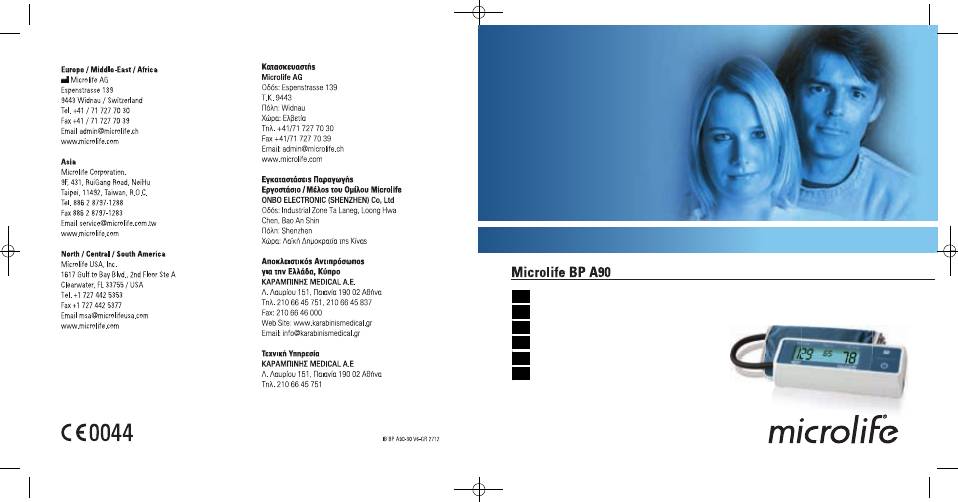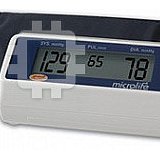Microlife BP A90-30: instruction
Class: Beauty, health, sport, tourism, hobbies
Type:
Manual for Microlife BP A90-30

EN
1
RU
6
DE
12
TR
18
AR
24
GR
30


1
BP A90
EN
Display
Read the instructions carefully before using this device.
Type BF applied part
Dear Customer,
Your new Microlife blood pressure monitor is a reliable medical
instrument for taking measurements on the upper arm. It is simple
to use, accurate and comes highly recommended for blood pres-
sure monitoring in your home. This instrument was developed in
collaboration with physicians and clinical tests proving its
measurement accuracy to be very high.*
Please read through these instructions carefully so that you under-
stand all functions and safety information. We want you to be
happy with your Microlife product. If you have any questions, prob-
lems or want to order spare parts, please contact Microlife-
Customer Service. Your dealer or pharmacy will be able to give
you the address of the Microlife dealer in your country. Alterna-
tively, visit the Internet at www.microlife.com where you will find a
wealth of invaluable information on our products.
Stay healthy – Microlife AG!
* This instrument uses the same measuring technology as the
award winning «BP 3BTO-A» model tested according to the British
Hypertension Society (BHS) protocol.
Table of Contents
1. Important Facts about Blood Pressure and Self-Measure-
ment
• How do I evaluate my blood pressure?
2. Using the Instrument for the First Time
• Inserting the batteries
• Selecting the correct cuff
3. Taking a Blood Pressure Measurement using this Instrument
4. Appearance of the Heart Arrhythmia Indicator for early
Detection
5. Data Memory
• Viewing the stored values
• Memory full
• Clearing all values
Microlife BP A90
EN
1
ON/OFF Button
2
Display
3
Cuff Socket
4
Battery Compartment
5
Cuff
6
Cuff Connector
AO
M-Button (Memory)
7
Systolic Value
8
Diastolic Value
9
Pulse
AT
Pulse Rate
AK
Battery Display
AL
Stored Value
AM
Memory Number
AN
Heart Arrhythmia Indicator

2
6. Battery Indicator and Battery change
• Low battery
• Flat battery – replacement
• Which batteries and which procedure?
• Using rechargeable batteries
7. Error Messages
8. Safety, Care, Accuracy Test and Disposal
• Safety and protection
• Instrument care
• Accuracy test
• Disposal
9. Guarantee
10. Technical Specifications
Guarantee Card (see Back Cover)
1. Important Facts about Blood Pressure and Self-
Measurement
Blood pressure
is the pressure of the blood flowing in the
arteries generated by the pumping of the heart. Two values, the
systolic
(upper) value and the
diastolic
(lower) value, are
always measured.
The instrument also indicates the
pulse rate
(the number of
times the heart beats in a minute).
Permanently high blood pressure values can damage your
health and must be treated by your doctor!
Always discuss your values with your doctor and tell him/her if
you have noticed anything unusual or feel unsure.
Never rely
on single blood pressure readings.
Enter your readings in the enclosed
blood pressure diary
.
This will give your doctor a quick overview.
There are many causes of excessively
high blood pressure
values
. Your doctor will explain them in more detail and offer treat-
ment where appropriate. Besides medication, relaxation techniques,
weight loss and exercise can also lower your blood pressure.
Under no circumstances should you alter the dosages of
any drugs prescribed by your doctor!
Depending on physical exertion and condition, blood pressure is
subject to wide fluctuations as the day progresses.
You should
therefore take your measurements in the same quiet condi-
tions and when you feel relaxed!
Take at least two measure-
ments per day, one in the morning and one in the evening.
It is quite normal for two measurements taken in quick succes-
sion to produce significantly
different results
.
Deviations
between measurements taken by your doctor or in
the pharmacy and those taken at home are quite normal, as
these situations are completely different.
Several measurements
provide a much clearer picture than
just one single measurement.
Leave a small break
of at least 15 seconds between two
measurements.
If you are
pregnant
, you should monitor your blood pressure
very closely as it can change drastically during this time!
If you suffer from an
irregular heartbeat
, measurements taken
with this instrument should only be evaluated after consultation
with your doctor.
The pulse display is not suitable for checking the
frequency of heart pacemakers!
How do I evaluate my blood pressure?
The higher value is the one that determines the evaluation.
Example: a readout value between
150/85
or
120/98
mmHg indi-
cates «blood pressure too high».
Table for classifying blood pressure values in adults in accordance
with the World Health Organisation (WHO) in 2003. Data in mmHg.
Range
Systolic Diastolic Recommendation
blood pressure too low
100
60
Consult your
doctor
1. blood pressure
optimum
100 - 120 60 - 80
Self-check
2. blood pressure normal
120 - 130 80 - 85
Self-check
3. blood pressure slightly
high
130 - 140 85 - 90
Consult your
doctor
4. blood pressure too
high
140 - 160 90 - 100
Seek medical
advice
5. blood pressure far too
high
160 - 180 100 - 110
Seek medical
advice
6. blood pressure
dangerously high
180
110
Urgently seek
medical advice!

3
BP A90
EN
2. Using the Instrument for the First Time
Inserting the batteries
After you have unpacked your device, first insert the batteries. The
battery compartment
4
is at the back of the device. Insert the
batteries (4 x size AA 1,5 V), thereby observing the indicated polarity.
Selecting the correct cuff
Microlife offers different cuff sizes. Select the cuff size to match the
circumference of your upper arms (measured by close fitting in the
centre of the upper arm).
Optional preformed cuffs «Easy» are available.
Only use Microlife cuffs.
Contact Microlife Service if the enclosed cuff
5
does not fit.
Connect the cuff to the instrument by inserting the cuff
connector
6
into the cuff socket
3
as far as it will go.
3. Taking a Blood Pressure Measurement using this
Instrument
Checklist for taking a reliable measurement
1. Avoid activity, eating or smoking immediately before the
measurement.
2. Sit down for at least 5 minutes before the measurement and relax.
3. Always measure on the same arm (normally left).
4. Remove close-fitting garments from the upper arm. To avoid
constriction, shirt sleeves should not be rolled up - they do not
interfere with the cuff if they are laid flat.
5. Always ensure that the correct cuff size is used (marking on the
cuff).
Fit the cuff closely, but not too tight.
Make sure that the cuff is positioned 2 cm above the elbow.
The
artery mark
located on the cuff (ca. 3 cm long bar) must
lie over the artery which runs down the inner side of the arm.
Support your arm so it is relaxed.
Ensure that the cuff is at the same height as your heart.
6. Press the ON/OFF button
1
to start the measurement.
7. The cuff will now pump up automatically. Relax, do not move
and do not tense your arm muscles until the measurement
result is displayed. Breathe normally and do not talk.
8. When the correct pressure is reached, the pumping stops and the
pressure falls gradually. If the required pressure was not reached,
the instrument will automatically pump some more air into the cuff.
9. During the measurement, the heart symbol
AT
flashes in the
display and a beep sounds every time a heartbeat is detected.
10.The result, comprising the systolic
7
and the diastolic
8
blood
pressure and the pulse
9
is displayed and longer beep is heard.
Note also the explanations on further displays in this booklet.
11.When the measurement has finished, remove the cuff.
12.Switch off the instrument. (The monitor does switch off auto-
matically after approx. 1 min.).
You can stop the measurement at any time by pressing the
ON/OFF button (e.g. if you feel uneasy or an unpleasant
pressure sensation).
4. Appearance of the Heart Arrhythmia Indicator for
early Detection
This symbol
AN
indicates that certain pulse irregularities were
detected during the measurement. In this case, the result may
deviate from your normal blood pressure – repeat the measure-
ment. In most cases, this is no cause for concern. However, if the
symbol appears on a regular basis (e.g. several times a week with
measurements taken daily) we advise you to tell your doctor.
Please show your doctor the following explanation:
Cuff size
for circumference of upper arm
S
17 - 22 cm (6.75 - 8.75 inches)
M
22 - 32 cm (8.75 - 12.5 inches)
L
32 - 42 cm (12.5 - 16.5 inches)
M - L
22 - 42 cm (8.75 - 16.5 inches)
Information for the doctor on frequent appearance of the
Arrhythmia indicator
This instrument is an oscillometric blood pressure monitor that
also analyses pulse frequency during measurement. The instru-
ment is clinically tested.
The arrhythmia symbol is displayed after the measurement, if
pulse irregularities occur during measurement. If the symbol
appears more frequently (e.g. several times per week on
measurements performed daily) we recommend the patient to
seek medical advice.
The instrument does not replace a cardiac examination, but
serves to detect pulse irregularities at an early stage.





